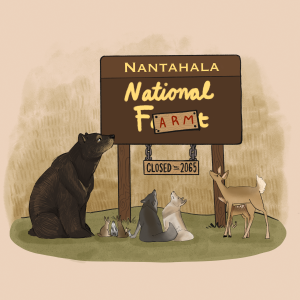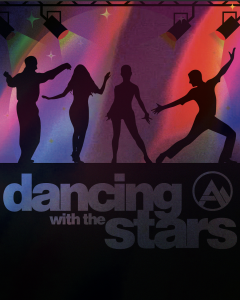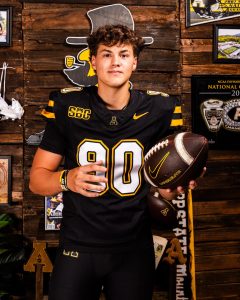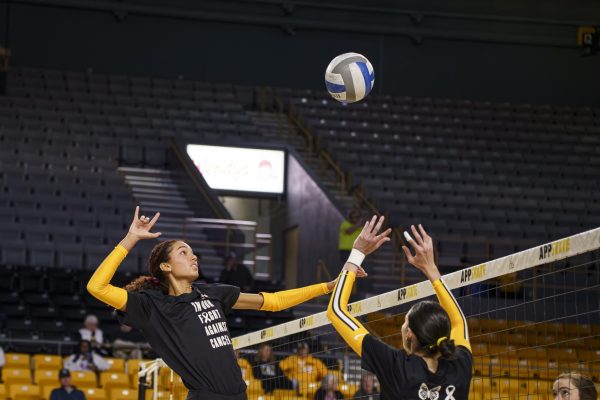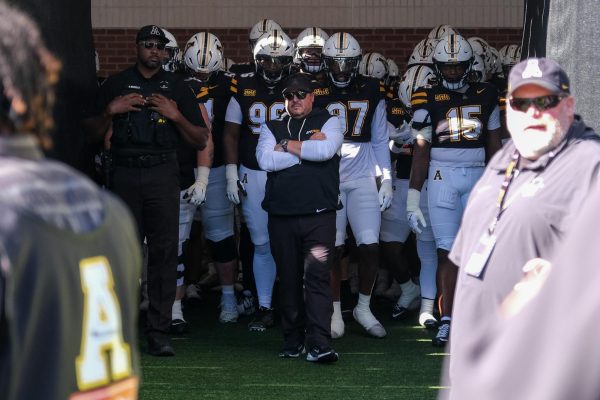New somatic sustainability minor added to Department of Theatre and Dance
March 21, 2019
With the addition of the somatic sustainability minor in fall 2018, dance professors Laurie Atkins and Marianne Adams are inspiring students of all disciplines to understand their bodies to positively impact the world.
The somatic sustainability minor has been almost a decade in the making. Adams said the inspiration for the new minor came from her and Atkins’ background in somatics and wanting to sustain their bodies as dancers. Atkins and Adams presented at the Association for the Advancement of Sustainability in Higher Education conference in October 2015. They expected no one to show up to their presentation, but the room was packed.
“We were speaking about this need to have a balancing embodied experience as opposed to just screens and frantically going around in the world,” Adams said.
Somatic sustainability combines somatics, the use of bodywork to study internal physical perception and experience, and sustainability. Somatic sustainability starts with looking inward, listening to one’s body and using this information to relate to social justice, the environment and the economy, according to the Department of Theatre and Dance’s website on somatic sustainability.
“Somatic sustainability work is work that is developing body awareness, habitual awareness, and that awareness then has the capacity to move an individual and a collective toward possible change,” Atkins said.
Atkins said living in a society that is numb ourselves all the time through screens and substances makes it difficult to develop mental, emotional and physical awareness and live fully in our bodies. Atkins said this minor is not just about self-care or the individual.
“It starts with individual work, but it’s all about how we potentially link our change of habits to making positive change in our community,” Atkins said.
Adams said somatic sustainability can help people love themselves more.
“If you learn something from those (somatic) practices of being nonviolent within your body or nonjudgmental within your body, how does that actually perhaps take you into a place of wanting to have a conversation with somebody that you know you don’t agree with?” Adams said.
Atkins said other universities offer majors and minors in somatics embedded within dance programs, but she doesn’t know of any other program that combines somatic work and sustainable development like App State.
To minor in somatic sustainability, a student must take both Principles of Sustainable Development and Somatics and Sustainable Practices, a course created for the minor. Then students can choose two of three options for bodywork classes: Yoga as Somatic Practice, Pilates Mat, consisting of core strengthening exercises on a mat, or Gyrokinesis, consisting of repetitive movements of the torso from a stool or a mat.
“It’s important to have a foot in more than one door because you might resonate with one physical experience more than another,” Atkins said.
Atkins said bodywork classes are important because change only starts when a person makes the exercise part of their routine.
“It’s like a system that you can work inside of, so you think about these larger ideas about what it is to have an embodied experience of the world, and then you can sit inside this system or this structure of Gyrokinesis to have a physical experience through that particular medium as one exploration,” Atkins said.
For the third part of the minor, a student can explore more in-depth with yoga, pilates or Gyrokinesis, or take floor-barre, Alexander Technique or somatics. With approval, students can choose a 3000 level course or higher in any other major or minor to fulfill the elective requirement. Atkins and Adams said they give students freedom with electives because somatic sustainability can relate to any discipline.
Junior theatre performance major Joy Siler said she became a somatic sustainability minor to study pilates more and to improve her acting.
“There is such a connection between acting and the body, and you have to know your body and know how to use your body,” Siler said.
Siler said playing Puck, a fairy hobgoblin, in the theater department’s upcoming production “A Midsummer Night’s Dream,” requires jumping and running around in a squat for the majority of the performance.
“Fortunately I do yoga and pilates regularly, and so I kind of have that strength and flexibility,” Siler said. “I can see that when I take care of my body, it allows me to do these cool things on stage that I otherwise wouldn’t be able to do.”
Siler is taking Somatics and Sustainable Practices this semester and said it took her a couple of weeks of reading and discussing articles to wrap her head around the complexity of somatic sustainability.
“If we can’t care for, understand and listen to our bodies, then how can we care for, understand and listen to the earth and what it needs?” Siler said.
If you’re interested in minoring in somatic sustainability, email Laurie Atkins or Marianne Adams. For more information about somatic sustainability visit the theater and dance department’s website.

